
The Country RFsThis page created 4th January 1998, updated 14th February 2002, best on 800*600.The original Country buses: 2RF2/2RF 514 - RF 700, Total 187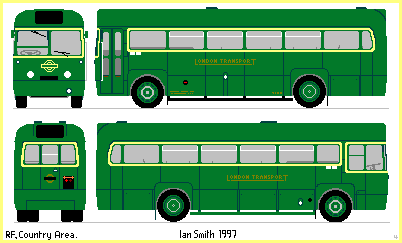 The first Country buses started to appear alongside the last Central buses,
in March 1953. The only substantial differences from the Central version
- apart from the green livery - were the provision of a pair of opening doors in the front entrance,
and the absence of the route stencil holder over the doorway.
Livery was Lincoln green with cream trim.
The radiator filler emblem was picked out in cream also,
with LONDON TRANSPORT written across the central bar in gold letters.
A bullseye transfer completed the rear.
The first Country buses started to appear alongside the last Central buses,
in March 1953. The only substantial differences from the Central version
- apart from the green livery - were the provision of a pair of opening doors in the front entrance,
and the absence of the route stencil holder over the doorway.
Livery was Lincoln green with cream trim.
The radiator filler emblem was picked out in cream also,
with LONDON TRANSPORT written across the central bar in gold letters.
A bullseye transfer completed the rear.
Whereas GreenLine and the Central Area had replaced their single-deck
vehicles route by route, the Country Area Area opted for
replacement of a complete garage at a time.
It was the head-quarters of the Southern and Northern Divisions that went first,
but that was because they had the oldest buses (4Q4s at RG and TFs at SA).
The other garages had had a clear-out of old types during the GreenLine RF
introduction, leaving them with demoted 10T10s
and Leyland Cubs in charge of single-deck bus work.
Summary
RF679 demonstrates the Country livery, posing with out-of-area Northern Division blinds for the 398 while at Limpsfield Chart in March 2000, and properly dressed for the 413 at Chevening Church in March 1999, in company with GS62.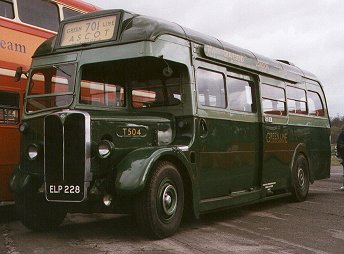
The 10T10s had not disappeared entirely either, as not enough RFs had been bought for entire displacement. It was the GS and RT classes that saw them off eventually, with some routes being deemed suitable for the midi-buses, (called small saloons in those days) and some suitable for double-decking. The Green Line RTs caused a reshuffle of the Greenline RFs, so Country bus RFs were no longer needed for GreenLine duplicates.
These changes provided enough RFs to replace the remaining 10T10s on "RF routes",
eg the 412 (DS), 413 (DG)and 489/A (NF), and also on the 441 (ST)
and the Hitchin works services.
The last scheduled 10T10 services were substituted by RFs by July 1954,
although a handful hung on as staff buses and for contracts until 1955.
The OMO Prototypes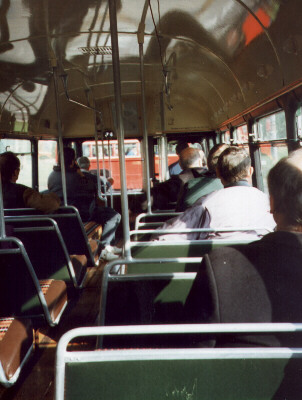 RF 517, 647 and 700 were held back for OMO modifications.
One Man operation was not legal on 41 seater buses at this time,
but a change in the regulations was expected.
The Leyland Cubs and their replacement Guy Specials were straightforwardly
designed for one man operation, with their normal control layout,
and were usually employed in this mode. Their OMO equipment was simple indeed:
a money dish and ticket machine on the driver's door sufficed.
But for the new OMO RFs much wider modifications were introduced:
a full height driver's door had a cinema-style screen with separate trays for
payment and change. Two ticket machines were fitted on the drivers side,
and a change machine delivered coins to the "change" dish when the
appropriate till keys were pushed by the driver.
To accommodate all this the driver's compartment was reshaped,
becoming larger at waist height, but being tucked in below this.
RF 517, 647 and 700 were held back for OMO modifications.
One Man operation was not legal on 41 seater buses at this time,
but a change in the regulations was expected.
The Leyland Cubs and their replacement Guy Specials were straightforwardly
designed for one man operation, with their normal control layout,
and were usually employed in this mode. Their OMO equipment was simple indeed:
a money dish and ticket machine on the driver's door sufficed.
But for the new OMO RFs much wider modifications were introduced:
a full height driver's door had a cinema-style screen with separate trays for
payment and change. Two ticket machines were fitted on the drivers side,
and a change machine delivered coins to the "change" dish when the
appropriate till keys were pushed by the driver.
To accommodate all this the driver's compartment was reshaped,
becoming larger at waist height, but being tucked in below this.The penning in of the driver made an driver emergency door necessary, and this was built into the driver's window. Instead of the two piece window, with the lower section sliding down, the whole was replaced by a hinged unit of which the central section slid upwards to open. There was an unobtrusive emergency handle on the outside also Another change was the removal of the front two sideways-facing seats on the nearside in exchange for a luggage pen. The buses were re-classified as 2RF5. These three also received the newly required reflectors on the rear (as did all the vehicles in London Transport during 1954). With the new regulations in force, the three were placed in service on the 419 local service in Epsom, working from Leatherhead, starting in February and March 1954. They were moved to Hemel Hempstead in August, for trials on the 316, jointly operated with Rover Bus Services. The trials having been successful, RF 649 was also modified, so that with RF 700 it could operate the 419 again (starting in December 54) . Inside a country RF (RF626) Fleet adjustmentsNow that all the RFs, GSs and RTs were delivered, (with spare RTs in store), LT took stock of its rolling stock provision for the next few years. The outcome of its deliberations were that the Country Area had a surplus of post-war single-deckers, as did Central area, but that GreenLine needed more to cater for its real expansion. Central Area protested (as we have seen in the red RF section), but nevertheless Central, Country and Private Hire sectors were required to surrender vehicles for conversion to Green Line coach specification.
The 1956 OMO route changes were like this:
More OMOAlthough LT had thought that the scope for one person operation of its "large saloons" would be severely limited, it began to have second thoughts as the success of the pilot batch and the improvements in crew wages began to have their effect. In 1957 another 45 Country RFs were to be altered, but this time to a simpler pattern. The cinema paydesk was abandoned in favour of a simpler arrangement of cash trays and machine on a half-door. The revised driver's window and reversing light were implemented, however. So that vehicles could be used for either OMO or crewed duties the Pay As You Enter window transfers were replaced by an orange plastic slipboard in a holder below the front nearside window. These conversions were coded RF5/2. It might have been expected that the buses chosen would all be from the end of the Country series, but it was now expected that eventually all RFs would be made capable of OMO so the conversions came from throughout the series.Some GS routes were taken over by the larger OMO RFs at this stage, the start of a trend.
The 1957 OMO route changes were like this:
In 1958 the pace of OMO conversion quickened, with another 70 RF conversions to RF5/2. Some routes were reorganised to take account of the change in operating practice, and some double-deck routes were converted too.
Return of the nativesWhen the Coach Routemasters were deployed to GreenLine in the latter half of 1962 they produced a surplus of coach RFs. The ex-Private Hire RFs were sold, and the RFs that had been Country buses but transferred to Green Line (RF 298-313) were all transferred back again. They had to be OMO converted on the way. This consisted of a flooring change and the cab/light conversions, but the seating was left in coach configuration. Later the front pair was removed to make way for a luggage rack, but this still left them with 38 rather than 39 seats. Their code was now 1/2RF5/4.(RF 309 and 313 had been painted in the pale green for the route 711 experiments and were left in it on transfer back to bus status, although the trim colour was changed to cream). GreenLine demotionsBy 1965 the effects of car ownership had had a drastic effect on the fortunes of Green Line, and the permanent demotion of 31 original Coach RFs to buses was authorised (Up until then demotions in duties had not involved alterations to the coaches). They were converted to OMO and lost the front pair of seats, making these 37 seaters coded 1/2RF5/5. One, RF 41, was altered back after a few months.
All these extra RFs were used for further conversions to OMO. All the remaining single-deck Country routes, including the 'town' services were changed over to OMO operation, as were a considerable number of double-deck routes. RLHs as well as RTs were affected, as the 336 was changed to OMO RF operation. More GS routes were changed to RF operation too.
By 1968 even the modernised Green Line RFs were being displaced,
by service cuts and new coaches, and 24 of the modernised RFs were downgraded.
The usual conversion work was carried out, but repainting involved
replacing the pale green band with canary yellow,
with 'London Transport' on it in green capitals.
DisplacementThe Country buses were also being displaced by new Merlins, despite the unreliability of the new buses, and by the end of 1968 a surplus of Country RFs was identified. As Central area still had a need for RFs for its own belated OMO programme, 13 Country RFs were transferred to the Central area on New Year's Day 1969. (RFs 545, 563, 570, 580, 590, 598, 602, 603, 608, 617, 627, 632, and 685) This was ironic, as within two years the Country Area was having to hire red RFs.
RT replacement continued (with RFs as well as MBs), especially on Sundays,
and some very long-established busy routes saw OMO RFs in place of RTs, such
as the 402 (Bromley-Sevenoaks-Tonbridge) and the Essex 371 group.
The immediate effect of the advent of London Country was that the legal lettering was changed, followed by
the fleetnames. LONDON COUNTRY replaced LONDON TRANSPORT, in canary yellow or black,
and the LT bullseye symbol was erased. This was easy enough with the transfers,
but not so easy with the radiator filler cover! Mostly this was just overpainted green
(in some cases not even matching green).
Despite their age, the RFs continued to survive.
This had much to do with the unreliability of their supposed replacements, the Merlin MBs, Swift SMs and the coach RCs and RPs.
The need for OMO single deckers was still growing too, as the RTs were retired and replaced by OMO vehicles, either double or single deckers.
The thirty Bristol BNs ordered in 1974 were direct RF replacements,
their 7ft 6in width allowing them to go anywhere an RF could.
They displaced the last bus RFs from Northfleet,
and made serious inroads into RF work at Dorking and Guildford.
Chelsham, Hertford and Leatherhead received the other BNs,
with concommitant loss of RF work during 1974 and 1975.
The replacement of the early Nationals by later coach versions released the
former to displace more RFs from bus work: the RFs disappeared quickly at this time.
Worse was to come. Short National Buses (SNB) were direct RF replacements.
The last active Country bus RF still in Country service was RF684,
which somehow had retained Lincoln green. It provided cover at Chelsham, pottering about the North Downs and Kent/Surrey border
until withdrawn on 20th May 1978.
RF 684 in the last days. Photo by Mike Dawes.
Preserved Country RFsThanks to Mike Dawes, and John Hinson for much of this information.As it goes out of date, please don't scream, but let me know! RF534 NLE 534, red bullseye livery. RF537 NLE 537, red bus livery, Acton Museum ----------------------------------------------- RF539 NLE 539 RF551 NLE 551, red bus livery, in store RF556 NLE 556, in store, tow-bus conversion RF573 NLE 573 RF579 NLE 579, Tow-launcher, Lincs RF580 NLE 580, in store RF591 NLE 591, in store RF600 NLE 600, original livery RF603 NLE 603, original livery, in store by Ensign RF626 NLE 626, original livery, 11.3 litre engine, Sussex RF627 NLE 627, original livery RF633 NLE 633, original livery RF636 NLE 636 RF643 NLE 643 RF644 NLE 644, Class VI, private hire, London, Surrey, Sussex RF652 NLE 652, spares RF667 NLE 667, original livery RF672 NLE 672, original livery RF673 NLE 673, RF676 NLE 676, RF679 NLE 679, original livery RF683 NLE 683, tea-room, Essex RF 626, 633 and 672 on the East Grinstead Running Day, April 1998.
|
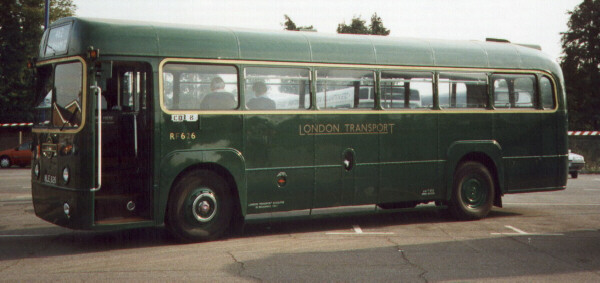
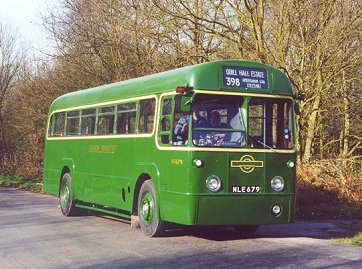
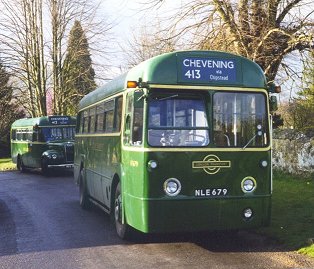
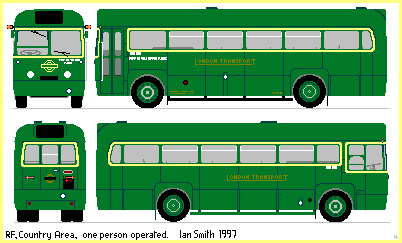 The Country vehicles selected were RFs 514 to RF 532
(with the exception of RF 517 - one of the OMO conversions),
plus RF 697 to make up for RF517.
They were renumbered into the GreenLine sequence,
taking numbers from Central RFs which in turn took the RF 514 to 532 numbers.
These vehicles were modified slightly to make them quickly suitable
for GreenLine operation: lino floors, repaint, roofboard clips
(mounted on a metal band rather than individually into the roof,
which provided a quick identifier for the conversions).
The luggage racks were fitted later,
and seat re-arrangements had to wait for the next overhaul.
The Country vehicles selected were RFs 514 to RF 532
(with the exception of RF 517 - one of the OMO conversions),
plus RF 697 to make up for RF517.
They were renumbered into the GreenLine sequence,
taking numbers from Central RFs which in turn took the RF 514 to 532 numbers.
These vehicles were modified slightly to make them quickly suitable
for GreenLine operation: lino floors, repaint, roofboard clips
(mounted on a metal band rather than individually into the roof,
which provided a quick identifier for the conversions).
The luggage racks were fitted later,
and seat re-arrangements had to wait for the next overhaul.
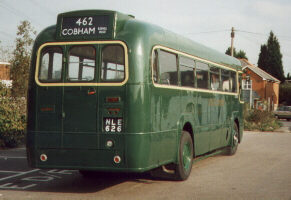
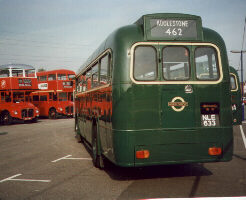
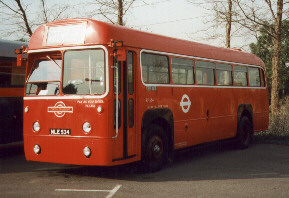
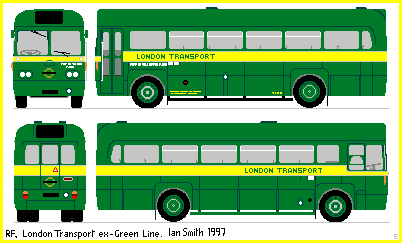 In 1966 and 1967 another 34 GreenLine RFs (all those not modernised)
were officially demoted to bus status and converted.
In 1966 and 1967 another 34 GreenLine RFs (all those not modernised)
were officially demoted to bus status and converted.
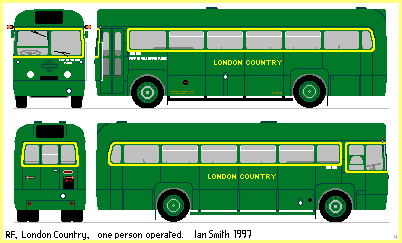 From January 1st 1970 London Country Buses Limited took over the entire
green RF stock, both Country Area and Green Line.
This comprised 413 RFs, 150 modernised Green Line coaches and 263 buses
(24 of them modernised ex-coaches).
At this stage none of the Country RFs had been withdrawn, remarkable for a fleet of buses sixteen years old!
London Country also continued the loan (now hire) of 5 Central Area red non-OMO RFs
(RF 393, 325, 341, 374 and 388). These returned to LT in November 1970 (393)
and March 1971, but were not used again by LT, being immediately withdrawn.
From January 1st 1970 London Country Buses Limited took over the entire
green RF stock, both Country Area and Green Line.
This comprised 413 RFs, 150 modernised Green Line coaches and 263 buses
(24 of them modernised ex-coaches).
At this stage none of the Country RFs had been withdrawn, remarkable for a fleet of buses sixteen years old!
London Country also continued the loan (now hire) of 5 Central Area red non-OMO RFs
(RF 393, 325, 341, 374 and 388). These returned to LT in November 1970 (393)
and March 1971, but were not used again by LT, being immediately withdrawn.
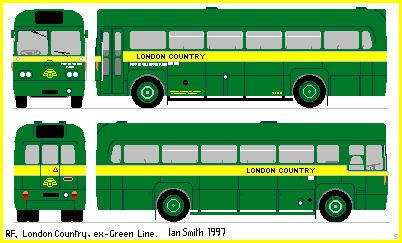 Then the flying polo symbol began to appear,
although it was more common on the modernised RFs than on the original version
(perhaps because it didn't fit between the mouldings of the old symbol
and the original numberplate location!).
But after a while the National Bus Company colours were asserted.
The traditional Lincoln green had been being replaced by lighter,
brighter greens at repaints,
but from October 72 the national leaf green began to be applied to the survivors.
Then the flying polo symbol began to appear,
although it was more common on the modernised RFs than on the original version
(perhaps because it didn't fit between the mouldings of the old symbol
and the original numberplate location!).
But after a while the National Bus Company colours were asserted.
The traditional Lincoln green had been being replaced by lighter,
brighter greens at repaints,
but from October 72 the national leaf green began to be applied to the survivors.
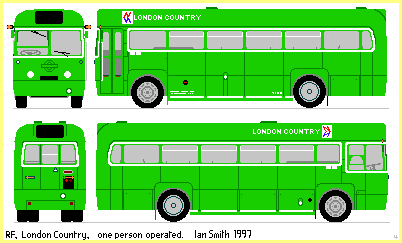 Trim was in white, either the original trim lines around the windows or the
cummerbund of the modernised buses (of which there were more by now).
Fleetnames were in NBC type, and the NBC double-N appeared in either white or red/blue form)
But this was not applied to the whole fleet, just to those that had to be repainted.
In other words, there was not a uniform livery, but a smorgasbord to choose from!
Trim was in white, either the original trim lines around the windows or the
cummerbund of the modernised buses (of which there were more by now).
Fleetnames were in NBC type, and the NBC double-N appeared in either white or red/blue form)
But this was not applied to the whole fleet, just to those that had to be repainted.
In other words, there was not a uniform livery, but a smorgasbord to choose from!
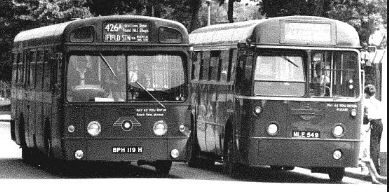
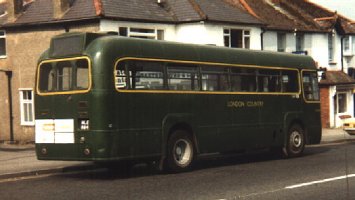
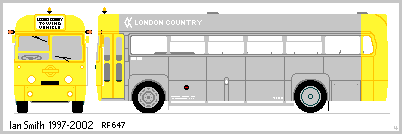 London Country converted three of its buses to tow-buses -
necessary as the newer buses arrived, with their increased rate of in-service breakdown.
Two of the three were Country bus RFs, RF556 and RF 647, converted in January 1973.
They were joined in October 1978 by ex_GreenLine RF79.
The trio retained their RF numbers, but gained grey and yellow liveries with added warning lights.
RF79 at least was cut-away at the rear to simplify towing.
RF647 was finally withdrawn in July 1979, RF556 in January 1981 and RF79 in May 1982.
London Country converted three of its buses to tow-buses -
necessary as the newer buses arrived, with their increased rate of in-service breakdown.
Two of the three were Country bus RFs, RF556 and RF 647, converted in January 1973.
They were joined in October 1978 by ex_GreenLine RF79.
The trio retained their RF numbers, but gained grey and yellow liveries with added warning lights.
RF79 at least was cut-away at the rear to simplify towing.
RF647 was finally withdrawn in July 1979, RF556 in January 1981 and RF79 in May 1982.
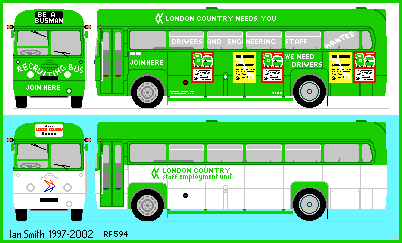 RF594 was converted to a recruiting vehicle in August 1973,
with internal tables, seats and cupboards for the task.
At first it was unimaginatively painted in overall NBC green,
with rallying cries applied in white lettering.
But early in 1976 it was repainted, with mainly white sides,
but NBC green uppers and wheel-arches.
It was retitled, in modern euphemism-speak, as a "staff employment unit".
It lasted until 1981.
RF594 was converted to a recruiting vehicle in August 1973,
with internal tables, seats and cupboards for the task.
At first it was unimaginatively painted in overall NBC green,
with rallying cries applied in white lettering.
But early in 1976 it was repainted, with mainly white sides,
but NBC green uppers and wheel-arches.
It was retitled, in modern euphemism-speak, as a "staff employment unit".
It lasted until 1981.
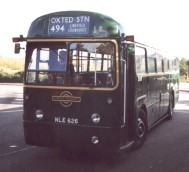
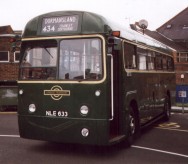
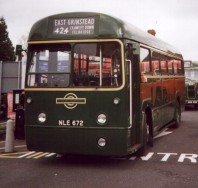
 Country RFs
Country RFs Country RF histories
Country RF histories Ian's Bus Stop
Ian's Bus Stop RF Contents
RF Contents Red RFs
Red RFs